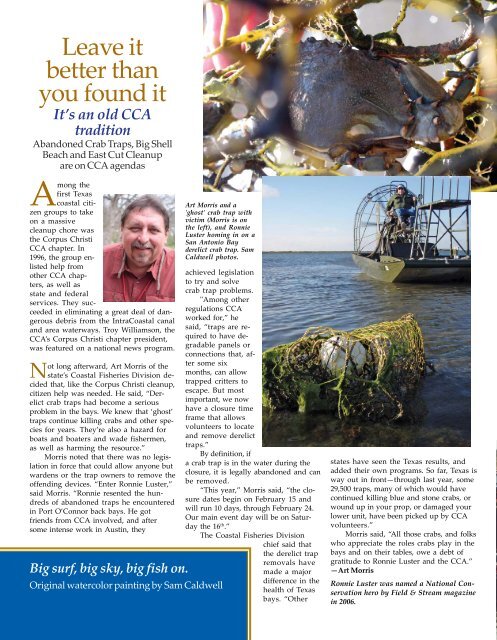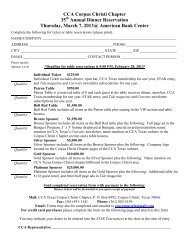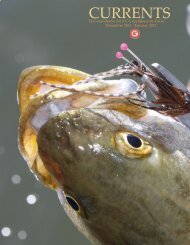CURRENTS OCT NOV 2011 - CCA Texas
CURRENTS OCT NOV 2011 - CCA Texas
CURRENTS OCT NOV 2011 - CCA Texas
You also want an ePaper? Increase the reach of your titles
YUMPU automatically turns print PDFs into web optimized ePapers that Google loves.
Leave itbetter thanyou found itIt’s an old <strong>CCA</strong>traditionAbandoned Crab Traps, Big ShellBeach and East Cut Cleanupare on <strong>CCA</strong> agendasAmong thefirst <strong>Texas</strong>coastal citizengroups to takeon a massivecleanup chore wasthe Corpus Christi<strong>CCA</strong> chapter. In1996, the group enlistedhelp fromother <strong>CCA</strong> chapters,as well asstate and federalservices. They succeededin eliminating a great deal of dangerousdebris from the IntraCoastal canaland area waterways. Troy Williamson, the<strong>CCA</strong>’s Corpus Christi chapter president,was featured on a national news program.Not long afterward, Art Morris of thestate’s Coastal Fisheries Division decidedthat, like the Corpus Christi cleanup,citizen help was needed. He said, “Derelictcrab traps had become a seriousproblem in the bays. We knew that ‘ghost’traps continue killing crabs and other speciesfor years. They’re also a hazard forboats and boaters and wade fishermen,as well as harming the resource.”Morris noted that there was no legislationin force that could allow anyone butwardens or the trap owners to remove theoffending devices. “Enter Ronnie Luster,”said Morris. “Ronnie resented the hundredsof abandoned traps he encounteredin Port O’Connor back bays. He gotfriends from <strong>CCA</strong> involved, and aftersome intense work in Austin, theyArt Morris and a'ghost' crab trap withvictim (Morris is onthe left), and RonnieLuster homing in on aSan Antonio Bayderelict crab trap. SamCaldwell photos.Front cover:Big surf, big sky, big fish on.Original watercolor painting by Sam Caldwellachieved legislationto try and solvecrab trap problems."Among otherregulations <strong>CCA</strong>worked for,” hesaid, “traps are requiredto have degradablepanels orconnections that, aftersome sixmonths, can allowtrapped critters toescape. But mostimportant, we nowhave a closure timeframe that allowsvolunteers to locateand remove derelicttraps.”By definition, ifa crab trap is in the water during theclosure, it is legally abandoned and canbe removed.“This year,” Morris said, “the closuredates begin on February 15 andwill run 10 days, through February 24.Our main event day will be on Saturdaythe 16 th .”The Coastal Fisheries Divisionchief said thatthe derelict trapremovals havemade a majordifference in thehealth of <strong>Texas</strong>bays. “Otherstates have seen the <strong>Texas</strong> results, andadded their own programs. So far, <strong>Texas</strong> isway out in front—through last year, some29,500 traps, many of which would havecontinued killing blue and stone crabs, orwound up in your prop, or damaged yourlower unit, have been picked up by <strong>CCA</strong>volunteers.”Morris said, “All those crabs, and folkswho appreciate the roles crabs play in thebays and on their tables, owe a debt ofgratitude to Ronnie Luster and the <strong>CCA</strong>.”—Art MorrisRonnie Luster was named a National Conservationhero by Field & Stream magazinein 2006.~2~






